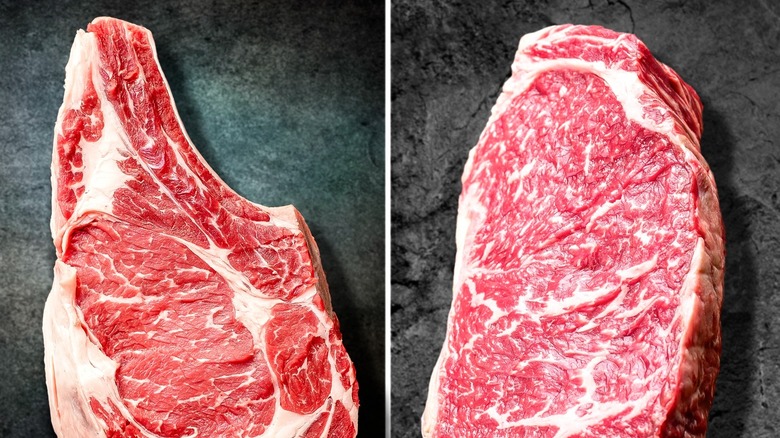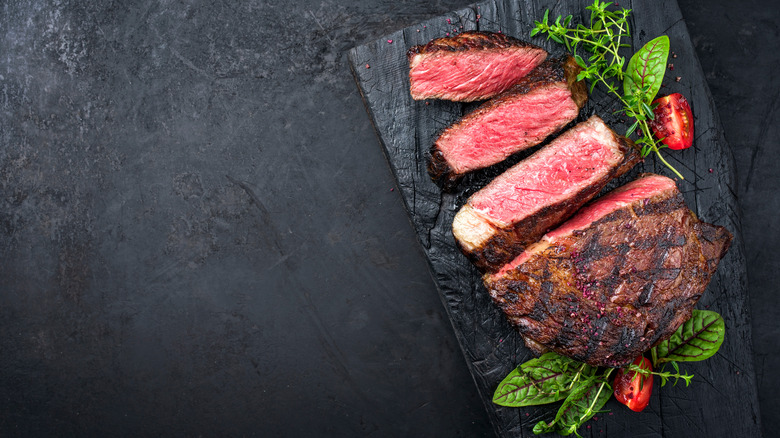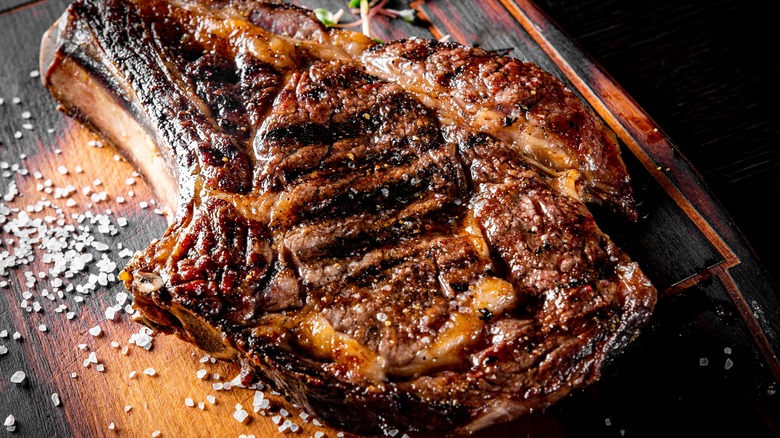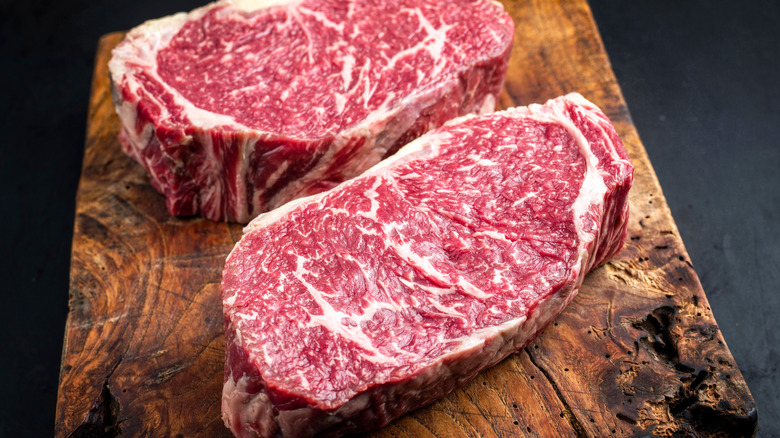Delmonico Steak Vs Cowboy Cut: Is There A Difference?
Steak night has a special appeal. Procure a delicious slab of meat, grill or broil at high heat, and voilà — a mouth-watering dinner appears. While the cooking process and ingredient list may not be exhaustive, much of the effort comes in the procurement of the cut itself. With dozens of options in many styles, sizes, and price ranges, selecting a cut of meat is understandably intimidating.
Fans of thick, beef-forward cuts of meat should look to cowboy and Delmonico steaks. These slabs of meat can both come in at an impressive two inches thick, typically complemented with dense fat marbling. Procured from the store, they're both fit for high-heat quick cooking, whether broiling or grilling. Yet, for more specific cooking details, it's helpful to know their sourcing, which is where the confusion arises.
A cowboy cut comes specifically from the ribs and includes a bone. However, a Delmonico refers to a broad array of steaks, which can be sourced from many different parts of the cow. Such a discrepancy is the result of confusion and disagreement in the culinary world.
What is a Delmonico steak?
A Delmonico steak refers to an assortment of cuts, which can be sourced from the rib section, short loin, or chuck part of the cow. The cut can be both bone-in and boneless; however, the top loin fillet or ribeye is a particularly popular version of the steak. Regardless of sourcing, the Delmonico is defined by its thickness — often two inches or more — as well as its fat marbling. Its stout consistency is accentuated with a rich, meaty flavor showcased through quick preparation methods like grilling and boiling.
The steak is named after the Delmonico restaurant in New York City, which opened in 1827. The exact cut served at the restaurant is debated and likely varied from night to night, but the establishment's style of steak has endured. Known for their thick cut and sparse seasoning, they're topped with only salt, pepper, and a basting of butter before being served alongside a compound butter.
What is a cowboy cut?
The cowboy cut is another large chunk of beef derived from the rib primal. It's cut from the back six ribs and served bone-in. Such qualities make it similar to a tomahawk steak, except this cut is more trimmed in terms of exterior meat, fat, and the length of the bone. It has delectable fat marbling, as well as a rich and tender interior. Plus, the adhered bone lends added insulation as well as an aesthetic flourish.
Cowboy steak is also a thick cut and, with its high-fat content, does especially well with fire-based cooking. They're delicious when grilled or broiled and can even be smoked for added flavor. To ensure the interior is prepared, it's helpful to employ the reverse sear method. A cowboy cut can feed several people, hence why it's usually sliced before serving. Like Delmonico steaks, a cowboy cut offers a big dose of beef flavor, so a salt and pepper garnish is all that's necessary for a delicious rendition.
Cowboy is a specific meat cut, unlike the Delmonico
Purchasing a Delmonico can encompass at least nine different steaks. From bone-in ribeyes interchangeable with the cowboy cut to a boneless chuck and short loin, there's no specificity to what's sold under the name. The current iteration of the Delmonico restaurant serves boneless ribeye. However, a top loin is also commonly referenced by the name. What's consistent is its thickness as well as its predisposition for quick, high-heat grilling. Nevertheless, keep in mind that it's a malleable term without regulation, so procure it from a reputable source.
Conversely, the cowboy cut is derived specifically from the rib primal. It encompasses its iconic frenched bone as well as three characteristic muscles. Due to its sourcing, it naturally comes in more than two inches thick. As it encompasses an entire eye and cap adhered to a rib, the weight clocks in closer to three pounds. As a result, it's a more definitive meat cut, only delineated by varying breeds– such as wagyu — rather than with an inconsistent composition.



